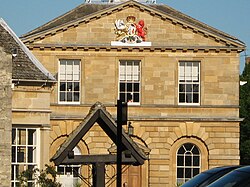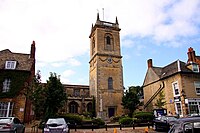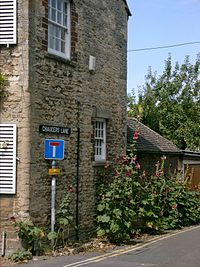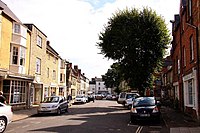Woodstock
| Woodstock | |
| Oxfordshire | |
|---|---|
 The Town Hall, Woodstock | |
| Location | |
| Grid reference: | SP444167 |
| Location: | 51°50’52"N, 1°21’23"W |
| Data | |
| Population: | 3,100 (2011) |
| Post town: | Woodstock |
| Postcode: | OX20 |
| Dialling code: | 01993 |
| Local Government | |
| Council: | West Oxfordshire |
| Parliamentary constituency: |
Witney |
| Website: | Woodstock Town Council |
Woodstock is a small market town in Oxfordshire, eight miles northwest of the City of Oxford. The 2011 Census recorded the parish population at 3,100.
The town is dominated by the neighbouring house, Blenheim Palace (a UNESCO World Heritage Site), which stands beside Woodstock and whose estate hems it in. The palace is the seat of the Duke of Marlborough, and was the birthplace in 1874 of Winston Churchill (who is buried in the nearby village of Bladon).
Edward, the Black Prince, elder son of King Edward III and heir apparent, prince of Aquitaine and Wales, Duke of Cornwall and Earl of Chester was born in Woodstock Manor on 15 June 1330. During his lifetime, he was commonly called Edward of Woodstock.
In the reign of Queen Mary I ("Bloody Mary"), her half-sister Princess Elizabeth was imprisoned in the gatehouse of Woodstock Manor.
Contents
History
The name Woodstock is Old English in origin, meaning a "clearing in the woods".
Æthelred the Unready, King of the English, is said to have held an assembly at Woodstock at which he issued a legal code now known as IX Æthelred.[1]
The Domesday Book of 1086 describes Woodstock (Wodestock, Wodestok, Wodestole) as a royal forest. King Henry I may have kept a menagerie in the park. Woodstock was the scene of King Henry II's courtship of Rosamund Clifford (Fair Rosamund). The market of the town was established when King Henry II gave Woodstock a Royal charter in 1179.[2]Bear Hotel in Park Street opposite The Oxfordshire Museum dates from the 13th century.
Near the village was Woodstock Palace, a residence that was popular with several English kings throughout the mediæval period. The building was destroyed in the Civil War. 60 years later the palace remains were cleared for the building of Blenheim Palace.
From the 16th century the town prospered by making gloves. Today it is largely dependent on tourists, many of whom visit Blenheim Palace.
Elizabeth I in prison
When Thomas Wyatt led an uprising in 1554 to depose Queen Mary I and put Princess Elizabeth on the throne in her place, Elizabeth was imprisoned in a lodge in Woodstock as a precaution. The lodge was used because the now lost Woodstock Palace or manor house was too dilapidated to house her. A survey in 1551 reported that "the mansion... for many years past hath been decayed."[2] While imprisoned, Elizabeth wrote a poem. "Much suspected by [of] me, None proved can be."[3] She was released in April 1555 after nearly a year in captivity.
Bell-foundry
By 1626 James Keene, who had a bell-foundry in Bedford, had started one in Woodstock.[4] Until 1640 another member of the family, Humphrey Keene, was a bell-founder with him.[4] James died in 1654 and was succeeded by his son Richard.[5] Richard Keene apparently closed the Woodstock foundry in the 1680s[5] but continued casting bells at Royston, Hertfordshire until 1703.[4]
Numerous parish churches in Oxfordshire, and surrounding counties still have one or more bells cast by the Keenes.
Blenheim Palace
- Main article: Blenheim Palace
In the 17th century the town was altered greatly, when the John Churchill, 1st Duke of Marlborough became a permanent resident.
Blenheim Palace, the Duke's home, was designed by John Vanbrugh, in a heavy Italo-Corinthian style. It was designated to John Churchill, the first Duke of Marlborough. Most of the palace was paid for by the nation. Churchill was given this palace in honour for his victories over the French and the Bavarians at Blenheim in 1704.
The greater part of the art treasures and curios were sold off in 1886, and the great library collected by Charles Spencer, Earl of Sunderland, the son-in-law of the first Duke of Marlborough, in 1881. The magnificent park contains Fair Rosamund's Well, near which stood her bower. On the summit of a hill stands a column commemorating the duke. Blenheim Park forms a separate parish.
Parish church
The Church of England parish church of St Mary Magdalene has a Norman doorway.[6] The church has a turret clock that John Briant of Hertford made in 1792.[7] The parish is now part of the Benefice of Blenheim, which also includes Begbroke, Bladon, Shipton-on-Cherwell and Yarnton.[8]
The town
The River Glyme, in a steep valley, divides the town into New and Old Woodstock. The town has two main suburbs: Hensington to the south and east of the town centre, and Old Woodstock to the north. The town hall of Woodstock was built in 1766 to designs by Sir William Chambers, and there are a number of 17th-century buildings in the town centre. The almshouses were built in 1798 on behalf of Caroline, duchess of Marlborough. Chaucer's House was once home to Chancellor of England, Thomas Chaucer, thought to be the son of the poet Geoffrey Chaucer.
The Oxfordshire Museum, the county museum of Oxfordshire, occupies a large historic house, Fletcher's House, in the centre of Woodstock. The museum has a garden containing works of art and a Dinosaur Garden with a full-size replica of a Megalosaurus.[9]
Sport and leisure
- Football: Old Woodstock Town
Outside links
| ("Wikimedia Commons" has material about Woodstock) |
- Wake Up to Woodstock – events, services, accommodation and news
- Woodstock Guide
- Woodstock – accommodation, attractions, businesses and information
References
- ↑ See Prosophography of Anglo-Saxon England. In the 17th century Robert Plot wrote that King Alfred stayed at Woodstock about the year 890 when he translated Boethius' Consolations of Philosophy. Plot, R (1677). "X, § 118". The Natural History of Oxfordshire. Oxford. p. 349.. The source cited by him was a "Cotton Otho A" manuscript, but no such manuscript has produced evidence of this. It may have been Cotton Otho A.x, destroyed in the Ashburnham House fire of October 1731, though the catalogues by Humfrey Wanley and Franciscus Junius make no mention of this. Griffiths, Bill (1991). Alfred's Metres of Boethius. Little Downham: Anglo-Saxon Books. p. 13. ISBN 0951620959.
- ↑ 2.0 2.1 Pipe, Simon (October 2007). "Woodstock's lost royal palace". BBC. http://www.bbc.co.uk/oxford/content/articles/2007/10/17/glyme_feature.shtml.
- ↑ Elizabeth I of England (4 December 2006). "Written on a Wall at Woodstock". Luminarium: Anthology of English Literature. Anniina Jokinen. http://www.luminarium.org/renlit/elizawoodstock.htm., citing Hentzner, Paul (1757) [1598]. Walpole, Horace. ed. A Journey Into England. and Dodsley, J, ed (1771). Fugitive Pieces on Various Subjects. II. p. 258.
- ↑ 4.0 4.1 4.2 Dovemaster (25 June 2010). "Bell Founders". Dove's Guide for Church Bell Ringers. Central Council for Church Bell Ringers. http://dove.cccbr.org.uk/founders.php. Retrieved 11 December 2010.
- ↑ 5.0 5.1 Crossley & Elrington 1990, pp. 360–372
- ↑ Sherwood & Pevsner 1974, p. 856.
- ↑ Beeson & Simcock 1989, pp. 24, 73.
- ↑ Archbishops' Council (2015). "Benefice of Blenheim". A Church Near You. Church of England. http://www.achurchnearyou.com/benefice.php?B=27/055BT. Retrieved 3 April 2015.
- ↑ "Dinosaur footprints go on display". BBC News. 10 May 2009. http://news.bbc.co.uk/1/hi/england/oxfordshire/8042832.stm.
Books
- Aston, Michael; Bond, James (1976). The Landscape of Towns. Archaeology in the Field Series. London: J.M. Dent & Sons Ltd. pp. 94, 165, 171. ISBN 0-460-04194-0.
- Ballard, Adolphus (1896). Chronicles of the royal borough of Woodstock. Compiled from the borough records and other original documents. Oxford: Alden & Co..
- Beeson, C.F.C. (1989) [1962]. A.V., Simcock. ed. Clockmaking in Oxfordshire 1400–1850 (3rd ed.). Oxford: Museum of the History of Science. pp. 24, 73. ISBN 0-903364-06-9.
- A History of the County of Oxford, Volume=12: Wootton Hundred (South) including Woodstock - Victoria County History
- Jenkins, S.C. (1987). The Woodstock Branch. Wild Swan Publications. ISBN 0-906867-51-7.
- Marshall, Edward (1873). The early history of Woodstock manor and its environs, in Bladon, Hensington, New Woodstock, Blenheim: with later notices. London & Oxford: James Parker & Co.
- Sherwood, Jennifer; Pevsner, Nikolaus (1974). Oxfordshire. The Buildings of England. Harmondsworth: Penguin Books. pp. 856–859. ISBN 0-14-071045-0.



